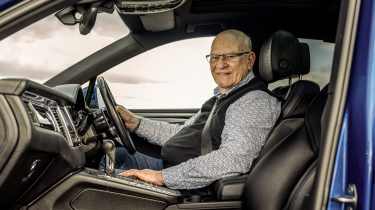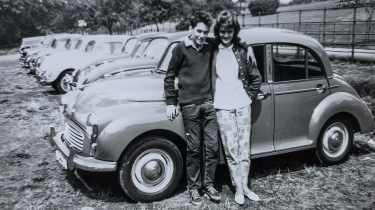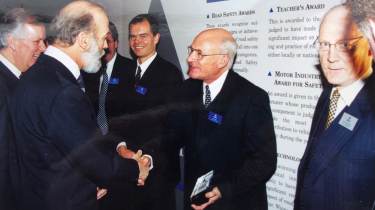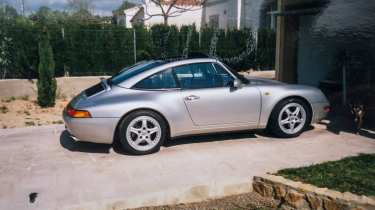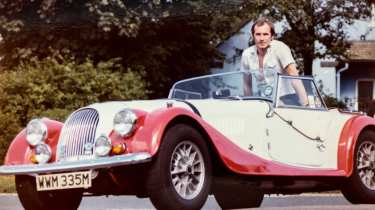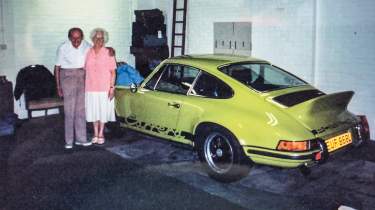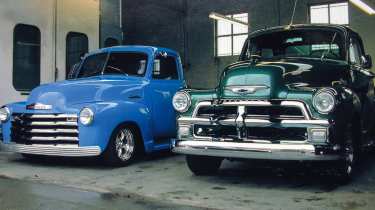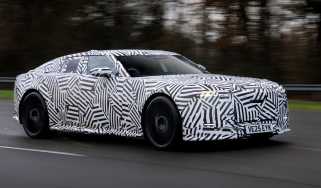How crashing a Lotus Cortina turned Paul Ripley into a driving guru
Serial 911 buyer Ripley has dedicated his life to making himself the best driver he can be – and passing his wisdom and experience on to a new generation of drivers
I’m a committed guy. Born grafter. If I set my mind to something, it will happen,’ says Paul Ripley, celebrated high performance driving guru. He grew up in a deprived part of Leeds in the ’50s, ‘in a one-up, one-down with a toilet at the end of the street’. His family was musical and he took up the drums at the age of five. ‘My uncle was a drummer in the army and it got a hold of me. I hated school with a vengeance and music was the way out. I’d come home and practise four hours a night in the outhouse, really regimented and disciplined.
‘I became quite a prolific player. I could sight-read just about anything and left school at 15 and became a professional musician. I worked with just about everybody – Tom Jones, Cilla Black, Brotherhood of Man – went around the world three times on cruise ships before I was 19, did cabaret, session recordings, big bands, jazz quintets… I earned a lot of money. There was a lot of drunks, a lot of druggies in the business but I was teetotal, focused. I didn’t have a drink until I was 50.’
Ripley had a weakness for cars though. ‘My dad had a Morris Minor and I learned to drive and skid in the field directly opposite. I eventually got that Minor off him. Then I bought a Mini and we put a 1071 Cooper S engine in it. It was ridiculous; great little car.’ Then came a Lotus Cortina. ‘The finance for the insurance was more than my mortgage at the time but I had to have it… and then I wrote it off.
‘It was a big shunt. Nearly killed myself. I was knocked out and trapped in the car. I got interviewed by the police in hospital. The copper said: “What speed were you doing around that corner, Paul?” I said: “What’s the speed limit on that road?” He said 40. I said: “Probably about 40, then.” He said: “Young man, Lotus Cortina… what’s the link?” I said I was just a driving fanatic. He said: “When you get out of hospital, do you want to come to the police skidpan at Crofton, Wakefield? We have an open evening every second Tuesday of the month.” So I went along. Wow. That’s what kicked it off. I thought, I want to do this. I can do this. That’s basically where it all started.’
On a trip to the 1976 German Grand Prix at Hockenheim in a borrowed van, Ripley bought a copy of Motor to read on the ferry and in the back pages he spotted an advert for The High Performance Course. ‘I thought: I can do that.’ He set about learning everything he could about driving. He’d earned so much as a drummer he didn’t have to work. ‘I gave up being a professional musician and studied for two years. I read everything I could. In the morning I’d do theory and in the afternoon I’d practise on the road. Utopia.’
He travelled the world for the next five years, trying everything. ‘I went drag racing, to skid control circuits, rally driving on loose surfaces and to race schools: Skip Barber’s, Jim Russell’s, Bob Bondurant’s… I think I went to 37 circuits in the States, Europe and Canada.’ He was also amassing qualifications but realised fairly early on that the learning was going to be an endless, ongoing process because perfection was unobtainable.
‘I remember getting this RoSPA [Royal Society for the Prevention of Accidents] diploma and all these fancy abbreviations behind it. The chief inspector said: “Really good drive that, lad.” Fantastic, thanks so much. They stood us all in a line and I was the last guy, the only civilian. He handed me my certificate and said: “There you are son, you’ve arrived,” and I said: “Where do I go now?” He said: “For what?” I said: “On a scale of one to ten, on a good day I’m on five, maybe five and a half. I’m not interested in a five and a half. Where do I go now to get to nine and a half?” He shook his head and said: “This is the highest form of driving competence in civilian life in Europe. Understand what I’m saying?” I said: “I don’t think you understand what I’m saying.” He said: “We beg to differ, you’ve arrived, well done.” I said: “I haven’t even started yet.”
In 1978 Ripley set up his first company, the Road and Track Performance Driving School. ‘In those days with no mobile phones, no internet, you were advertising in the back of magazines, half a page at £500 a shot. Took me a long time to get established, a long time.’
Ripley’s dedication led him to continue to seek out great drivers to learn from. The best, the ones that influenced him, developed his skills or gave him the impetus to develop his own skills, were Mike Franey and Jim Brown. Franey, an accomplished racer, was well known in driver development circles. They’d meet at Bruntingthorpe, the Leicestershire airfield turned test track.
‘I had an M5 at the time, first-model M5, and I used to turn up with two sets of tyres. I’d book it for two hours and we’d go through both sets in that time, learning how to powerslide at 120mph. While I was doing that, he’d make me do things like steer with one hand and put a flat cap on with the other. One time he brought this Rolls-Royce down that was an absolute animal, but it just wouldn’t go into oversteer. I’d tip it in at 100mph, I’m braking into it, nothing. He showed me how to do it. Unbelievable. His road driving wasn’t very good so we’d spend the morning on the track and in the afternoon I’d take him road driving, so it was completely free.’
A great influence on Ripley’s road driving was Jim Brown, a high performance course guy up in Scotland. ‘Total legend. Just a building construction engineer. I used to spend days with him at a time. He was into road driving in an incredible way, a total master at his art. I used to watch his feet and think, what the flip is going on down there? I remember one time he was driving my car [a Sapphire Cosworth, chipped to just shy of 500bhp] and he’s going seriously quickly and there’s like six “sharp deviation of route” signs and double unbroken whites leading into a completely blind left-hander. We’re in fourth, his hand goes down to the gearlever and I think he’s going to slide it into third. No. Up to fifth, back on the power. I’m thinking, holy shit, and as soon as he put his hand back on the wheel I could feel that brake retardation. Next thing he’s in second, spot-on speed for this blind bend. It was poetry in motion. I’m thinking, compared to this guy I’m a complete beginner.
‘He was the first guy that ever moulded track techniques into a road drive. He used to do sustained-rev gearchanging. No heel and toe. He used to brake and then be on the throttle from fifth to second or whatever it was, let his foot off the brake, you couldn’t feel it, and he’d be back on the power again. Meeting Franey, Brown and all these great people, I’d come away with a load of stuff in my head that I wanted to develop. I used to practise, practise, practise until I got their skill.’
There were some tasty cars along the way, many of them 911s – 37 at the last count – but Ripley’s had a few Ferraris too. ‘I bought a 246 Dino for four grand. Never knew if it was going to start though. Had it six months and a guy gave me £10k for it. He said, “Do you want to part-ex it for a 308 GTS in white?” which is very unusual. So I did. Had that car for six months, sold it for £21k. Then I bought a 328 GTS, then a 355 GTS – I absolutely loved that car. I love cars that say “I will bite your fricking arse”, which is probably why I like old 911s so much.’
By 1990, Ripley’s driver training business was starting to gain traction. Then he got a call from Lotus. ‘That changed everything. It was Alistair McQueen: “We need a driver trainer who knows his beans.” God, that guy, what a driver.’
After a four-day ‘audition’, Ripley got the job. ‘I used to go over there three weeks out of four and do driver training five days a week, four drivers a day, then write an assessment and give them a score. What graft that was. I did that for three or four years. Then I went to South Korea with Alistair and we trained all the Hyundai drivers.’
As his reputation grew, Ripley changed his company name to Paul Ripley Driving Courses and he was approached by The Telegraph newspaper to write a column for its motoring section. It was the start of a remarkable relationship that raised Ripley’s profile ever higher and spanned nine years. It started as ‘Safer Driving with Paul Ripley’, eventually becoming ‘Ask Ripley’, where he would answer three questions a week. He then wrote the acclaimed high performance driving book aptly titled Expert Driving.
There was clearly a thirst for driving knowledge and insight, though not all who came for personal training shared it. ‘You used to get a lot of them: “I know what I’m doing; I don’t really know why I’m here.” We’d come out of the house into a 30 limit, then a 40 limit and downhill into another 30 limit. With this one guy, we went into this 30 limit at 85mph. I said to him: “What’s the last traffic sign you saw?” He said:, “I’m going that fricking fast I don’t know!” I said, if you start braking now there’s a lay-by two and a half miles up the road. We might just slow down enough to pull in and have a chat.
‘I asked him, “What does high performance driving mean to you?” His answer: “Stick it in gear, give it a bootful?” I said, “Could it mean another level of performance from you, the driver?” He looked at me like, where’s this going? I said, “What you’ll learn about high performance driving, you’ll be driving slower than probably you’ve ever driven in built-up zones; 75 per cent of traffic crashes happen in 30 zones, you need to be driving at 30. And it’ll be great for you and brilliant for your discipline.” By the end of the day, he’s completely converted.
‘It’s almost a behavioural change they go through. You’re driving slower? That’s right. It’s a high performance course, a higher level of performance from you the driver. They eventually get it. Great, come back in six months’ time. They do and a completely different guy turns up. He’s got a faster car but he drives it so well. And I love it.
‘It’s self-discipline. You can’t just be a master of going fast. You want to be a master of everything, and that includes discipline. I’ve driven 57, 58 years with a completely clean licence. Never had a crash [since the Cortina]. I’m often asked “What’s the most difficult skill to get right?” It’s road driving, every day, because you’ll never get the same drive, you never get the same equations to deal with.’
In 2000 Ripley sold the business to Brands Hatch. ‘They bought the name, the brand. I couldn’t fart without them knowing. So we buggered off to Vancouver because my wife’s Canadian. I got into muscle cars big time: pickups, Stingrays, Camaros, big-block Chevelles... I had 11 cars at one time and a house with a centrally heated, five-car garage. I was buying and selling cars and houses to make some money because I wasn’t allowed to earn any from driver training. We stayed for a few years.’
This year, at the age of 75, Ripley’s back in the business of elite driver training. He’s recruited what he thinks are the 20 or so best high performance/advanced driving instructors in the UK to deliver training for his new venture, Driving Masters. ‘I’ll write blogs and articles on mindset, skills and techniques and talk to customers.
‘I get up at 5.30 every day and work for three hours before the missus gets up. She thinks I’m a nutcase but that’s me: I’m disciplined, I want to produce, I want to do shit. And I want to get better at everything I do. I may just need another 911 too!
‘I’ll get into the Macan and just go out for an hour on B-roads. I’m just a really keen enthusiast; that’s never left me. I don’t want it to ever leave me.’
This story was first featured in evo issue 325.

